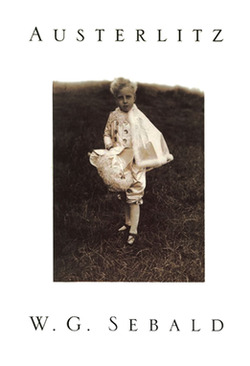Austerlitz (novel): Difference between revisions
| Line 20: | Line 20: | ||
==Plot summary== |
==Plot summary== |
||
Jacques Austerlitz, the main character in the book, is an architectural historian who encounters and befriends the solitary narrator in [[Antwerp]] during the 1960s. Gradually we come to understand his life history. He arrived in [[United Kingdom|Britain]] during the summer of 1939 as an infant refugee on a [[kindertransport]] from a [[Czechoslovakia]] threatened by [[Hitler]]'s [[Nazis]]. He was adopted by an elderly [[Wales|Welsh]] [[Calvinist]] preacher and his sickly wife, and spent his childhood in Mid Wales before attending a minor public school. His foster parents died, and Austerlitz learned something of his background. After school he attended university and became an academic who is drawn to, and began his research in, the study of European architecture. After a breakdown, Austerlitz visited [[Prague]] and from there traveled to [[Theriesenstadt]]. Here we learn about the disappearance of [[ |
Jacques Austerlitz, the main character in the book, is an architectural historian who encounters and befriends the solitary narrator in [[Antwerp]] during the 1960s. Gradually we come to understand his life history. He arrived in [[United Kingdom|Britain]] during the summer of 1939 as an infant refugee on a [[kindertransport]] from a [[Czechoslovakia]] threatened by [[Hitler]]'s [[Nazis]]. He was adopted by an elderly [[Wales|Welsh]] [[Calvinist]] preacher and his sickly wife, and spent his childhood in Mid Wales before attending a minor public school. His foster parents died, and Austerlitz learned something of his background. After school he attended university and became an academic who is drawn to, and began his research in, the study of European architecture. After a breakdown, Austerlitz visited [[Prague]] and from there traveled to [[Theriesenstadt]]. Here we learn about the disappearance of [[Jew|European Jewry]] during the [[Holocaust]]. |
||
The novel shifts to contemporary [[Paris]] as Austerlitz seeks out any remaining evidence about the fate of his father. Sebald explores the ways in which collections of records, such as the [[Bibliothèque nationale de France]] (BnF) or National Library of France, entomb memories. At the end of the novel we have been taken on a guided tour of the ruins of a lost European civilisation: a world of fortresses, torture chambers, [[concentration camps]] and [[death camps]], and the railways that connect them. |
The novel shifts to contemporary [[Paris]] as Austerlitz seeks out any remaining evidence about the fate of his father. Sebald explores the ways in which collections of records, such as the [[Bibliothèque nationale de France]] (BnF) or National Library of France, entomb memories. At the end of the novel we have been taken on a guided tour of the ruins of a lost European civilisation: a world of fortresses, torture chambers, [[concentration camps]] and [[death camps]], and the railways that connect them. |
||
Revision as of 17:10, 3 April 2008
 | |
| Author | W. G. Sebald |
|---|---|
| Translator | Anthea Bell |
| Cover artist | Andy Carpenter |
| Language | German |
| Genre | Historical novel |
| Publisher | Random House, C. Hanser |
Publication date | 2001 |
| Publication place | Germany |
| Media type | Print (Hardback & Paperback) |
| ISBN | ISBN 0-375-50483-4 Parameter error in {{ISBNT}}: invalid character |
Austerlitz is the final novel of W. G. Sebald, published in 2001. It is one of the most significant German language works of fiction for the period since the Second World War.
Plot summary
Jacques Austerlitz, the main character in the book, is an architectural historian who encounters and befriends the solitary narrator in Antwerp during the 1960s. Gradually we come to understand his life history. He arrived in Britain during the summer of 1939 as an infant refugee on a kindertransport from a Czechoslovakia threatened by Hitler's Nazis. He was adopted by an elderly Welsh Calvinist preacher and his sickly wife, and spent his childhood in Mid Wales before attending a minor public school. His foster parents died, and Austerlitz learned something of his background. After school he attended university and became an academic who is drawn to, and began his research in, the study of European architecture. After a breakdown, Austerlitz visited Prague and from there traveled to Theriesenstadt. Here we learn about the disappearance of European Jewry during the Holocaust.
The novel shifts to contemporary Paris as Austerlitz seeks out any remaining evidence about the fate of his father. Sebald explores the ways in which collections of records, such as the Bibliothèque nationale de France (BnF) or National Library of France, entomb memories. At the end of the novel we have been taken on a guided tour of the ruins of a lost European civilisation: a world of fortresses, torture chambers, concentration camps and death camps, and the railways that connect them.
Formally, the novel is notable because of the lack of paragraphing, a digressive style, the blending of fact and fiction, and the inclusion of a set of mysterious and evocative photographs, scattered throughout the book, that enhances the melancholy message of the text. Many of these features characterize Sebald's other works of fiction, including The Emigrants, The Rings of Saturn and Vertigo.
In terms of the subject matter, the novel shares some of the concerns of La disparition (A Void), a novel by the French writer Georges Perec that also alludes to the Holocaust. The historical aftereffects linking Europe's tragic wartime experiences under the Nazis with those living in the present are also featured in the German novels Im Krebsgang (2002) (English translation: Crabwalk), by Günter Grass, and Marcel Beyer's 1995 'Flughunde.'
Editions
- Austerlitz. Translated by Anthea Bell. New York : Random House, 2001.
- Austerlitz. München: C. Hanser, 2001.
